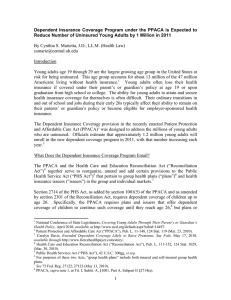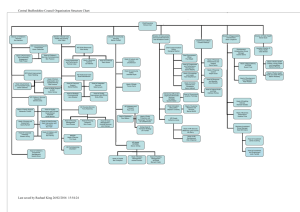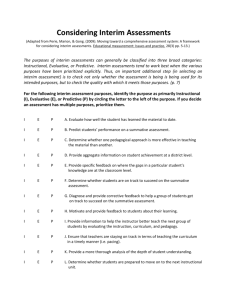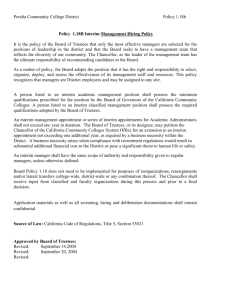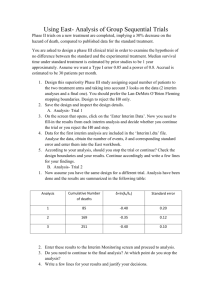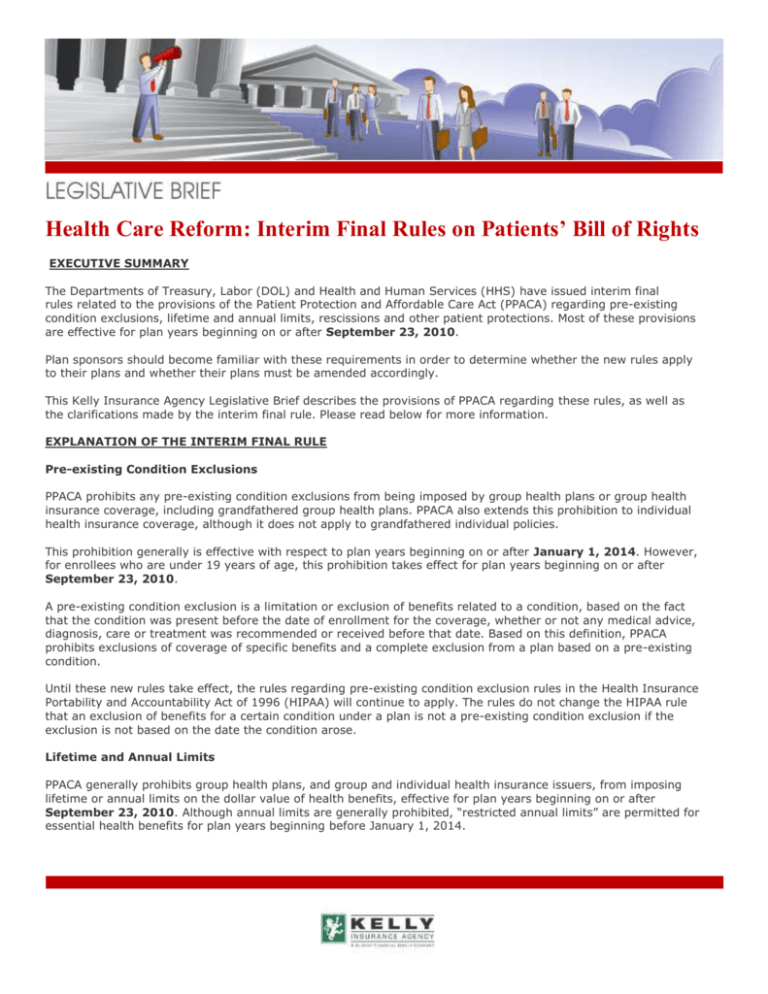
Health Care Reform: Interim Final Rules on Patients’ Bill of Rights
EXECUTIVE SUMMARY
The Departments of Treasury, Labor (DOL) and Health and Human Services (HHS) have issued interim final
rules related to the provisions of the Patient Protection and Affordable Care Act (PPACA) regarding pre-existing
condition exclusions, lifetime and annual limits, rescissions and other patient protections. Most of these provisions
are effective for plan years beginning on or after September 23, 2010.
Plan sponsors should become familiar with these requirements in order to determine whether the new rules apply
to their plans and whether their plans must be amended accordingly.
This Kelly Insurance Agency Legislative Brief describes the provisions of PPACA regarding these rules, as well as
the clarifications made by the interim final rule. Please read below for more information.
EXPLANATION OF THE INTERIM FINAL RULE
Pre-existing Condition Exclusions
PPACA prohibits any pre-existing condition exclusions from being imposed by group health plans or group health
insurance coverage, including grandfathered group health plans. PPACA also extends this prohibition to individual
health insurance coverage, although it does not apply to grandfathered individual policies.
This prohibition generally is effective with respect to plan years beginning on or after January 1, 2014. However,
for enrollees who are under 19 years of age, this prohibition takes effect for plan years beginning on or after
September 23, 2010.
A pre-existing condition exclusion is a limitation or exclusion of benefits related to a condition, based on the fact
that the condition was present before the date of enrollment for the coverage, whether or not any medical advice,
diagnosis, care or treatment was recommended or received before that date. Based on this definition, PPACA
prohibits exclusions of coverage of specific benefits and a complete exclusion from a plan based on a pre-existing
condition.
Until these new rules take effect, the rules regarding pre-existing condition exclusion rules in the Health Insurance
Portability and Accountability Act of 1996 (HIPAA) will continue to apply. The rules do not change the HIPAA rule
that an exclusion of benefits for a certain condition under a plan is not a pre-existing condition exclusion if the
exclusion is not based on the date the condition arose.
Lifetime and Annual Limits
PPACA generally prohibits group health plans, and group and individual health insurance issuers, from imposing
lifetime or annual limits on the dollar value of health benefits, effective for plan years beginning on or after
September 23, 2010. Although annual limits are generally prohibited, “restricted annual limits” are permitted for
essential health benefits for plan years beginning before January 1, 2014.
Health Care Reform: Interim Final Rules on Patients’ Bill of Rights
Restricted Annual Limits
The interim final rules establish a three-year phased approach for restricted annual limits. Annual limits may not be
less than the following amounts for plan years beginning before January 1, 2014:
$750,000 for plan years beginning on or after September 23, 2010, but before September 23, 2011;
$1.25 million for plan years beginning on or after September 23, 2011, but before September 23, 2012;
and
$2 million for plan years beginning on or after September 23, 2012, but before January 1, 2014.
These are minimums for plan years; plans may use higher annual limits or impose no limits. The limits apply on an
individual-by-individual basis, so that any annual limit on benefits applied to families cannot cause an individual to
be denied the minimum annual benefit for the plan year.
The restricted annual limits are designed to ensure that individuals would have access to needed services with a
minimal impact on premiums. However, they could affect limited benefit plans or “mini-med” plans that generally
have limits significantly below the permitted limits. The regulations provide that the restricted annual limits could
be waived by the Department of Health and Human Services (HHS) if compliance with the restrictions would result
in a significant decrease in access to benefits or a significant increase in premiums. HHS has released guidance on
how to apply for a waiver.
In general, plans must apply for the waiver at least 30 days before the beginning of the plan or policy year. However,
plans with plan years beginning before November 2, 2010 must apply at least 10 days before the beginning of the
plan or policy year. The HHS Bulletin released November 5, 2010 indicates that in states where issuers are required
by state law to offer policies with annual limits below the minimum requirements, a state may apply for a waiver of
the restricted annual limits on behalf of issuers of these state-mandated policies if state law required the policies to be
offered prior to September 23, 2010. The application must still satisfy the standard that compliance with the limits
would result in either a significant decrease in access to benefits or a significant increase in premiums.
In its Bulletin, HHS stated that as a condition of receiving a waiver, a group health plan or health insurance issuer
must provide a notice informing each participant that the plan or policy does not meet the restricted annual limits for
essential benefits because it has received a waiver of that requirement. The notice requirement applies to waivers that
were granted prior to November 5, as well as to future waivers. Issuers receiving a waiver under the state process
must also provide the required notice.
Covered Plans
The prohibition on lifetime and annual limits applies to both new and grandfathered group health plans. However, it
does not apply to grandfathered individual policies. The restrictions on annual limits do not apply to account-based
plans like health flexible spending arrangements (health FSAs), medical savings accounts (MSAs), health savings
accounts (HSAs) and health reimbursement arrangements (HRAs).
Essential Health Benefits
PPACA specifically provides that plans may impose annual or lifetime per-individual limits on specific covered
benefits that are not “essential health benefits.” Regulations still need to be issued on the definition of essential
health benefits, but it will include at least the following general categories of items and services:
Ambulatory patient services;
Emergency services;
Hospitalization;
Maternity and newborn care;
Mental health and substance use disorder services, including behavioral health treatment;
Health Care Reform: Interim Final Rules on Patients’ Bill of Rights
Prescription drugs;
Rehabilitative and habilitative services and devices;
Laboratory services;
Preventive and wellness services, including chronic disease management; and
Pediatric services, including oral and vision care.
Until those regulations are issued, plans can use a good faith effort to comply with a reasonable interpretation of
essential health benefits and must apply it consistently.
The interim final rules clarify that a plan can still exclude all benefits for a condition. Such an exclusion will not be
considered an annual or lifetime limit as long as no benefits are provided for the condition.
Enrollment Opportunities
Under the interim final rules, individuals who reached a lifetime limit prior to the date the regulations are effective
and are otherwise eligible for plan coverage must be given a notice that the lifetime limit no longer applies. They
must also be permitted to re-enroll in the plan if they are no longer enrolled. The notices and enrollment
opportunity must be provided no later than the first day of the first plan year beginning on or after September 23,
2010. Anyone who is eligible for the enrollment opportunity must be treated as a special enrollee who is eligible to
enroll in all of the benefit packages available to similarly situated individuals upon initial enrollment.
Rescissions
PPACA and the interim final rules place limits on the ability of a group health plan, or group and individual health
insurance issuer, to rescind health coverage. Effective for plan years beginning on or after September 23, 2010,
coverage may be rescinded only in the case of fraud or intentional misrepresentation of a material fact. Fraud may
include an omission of relevant facts. This standard applies to all rescissions, whether in the group or individual
market, and whether the coverage is insured or self-funded. If a state law is more protective of individuals than the
federal law, the state law will continue to apply.
For purposes of the interim final rule, a rescission is a cancellation or discontinuation of coverage that has a
retroactive effect. For example, a cancellation that treats a policy as void from the time of enrollment is a
rescission. Prospective cancellations and retroactive cancellations due to a failure to pay required premiums would
not be considered rescissions.
The prohibition on rescissions applies whether the rescission applies to an individual, an individual within a family,
or an entire group of individuals. The rules on rescissions also apply to representations made by the individual or a
person seeking coverage on behalf of the individual, such as the plan sponsor.
In addition to setting federal requirements for rescissions, PPACA adds a new advance notice requirement when
coverage is rescinded where still permissible. Group health plans and group health insurance issuers must provide
at least 30 calendar days advance noticed to an individual before coverage may be rescinded. This 30-day period
will provide individuals and plan sponsors with an opportunity to contest the rescission or look for alternative
coverage.
The rules regarding rescission and advance notice apply to all grandfathered health plans.
Patient Protections
PPACA imposes three new requirements on group health plans and group or individual health insurance coverage
that are referred to as “patient protections.” These patient protections relate to the choice of a health care
professional and benefits for emergency services and are effective for plan years beginning on or after September
23, 2010. They do not apply to grandfathered plans. The rules regarding choice of health care professional apply
only to plans that have a network of providers.
Health Care Reform: Interim Final Rules on Patients’ Bill of Rights
Choice of Primary Care Provider
If a group health plan, or group or individual health insurer, requires a participant to designate a primary care
provider, the participant must be able to choose any participating primary care provider who is able to accept the
participant as a patient. This rule includes a pediatrician as the primary care provider for a child. The plan must
provide a notice informing each participant of the plan’s terms regarding primary care provider designation. The
notice should be included in the plan’s summary plan description. The interim final rules include model language for
this notice.
OB/GYN Care
Plans that provide coverage for obstetrical and/or gynecological care (ob/gyn care) and require the patient to
designate an in-network primary care provider may not require preauthorization or referral for a female participant
seeking such care. The plan must inform each participant of these rules and should include the notice in its
summary plan description. Model language is included in the interim final rules. A plan may still require the ob/gyn
provider to follow any policies or procedures regarding referrals, prior authorization for treatments and the
provision of series.
Emergency Services
PPACA places additional requirements on plans and health insurance issuers that provide hospital emergency room
benefits. Plans and issuers must provide those benefits without requiring prior authorization and without regard to
whether the provider is an in-network provider.
Also, the plan or issuer may not impose requirements or limitations on out-of-network emergency services that are
more restrictive than those applicable to in-network emergency services. Cost sharing requirements, such as
copayments or coinsurance rates, imposed for out-of-network emergency services cannot exceed the cost-sharing
requirements for in-network emergency services.
Despite this rule, out-of-network providers may balance bill patients, as long as the plan or issuer has paid a
reasonable amount for the services. The interim final rules provide guidance on determining whether the amount
paid is reasonable. Also, other cost-sharing requirements, such as deductibles or out-of-pocket maximums, may be
imposed on out-of-network emergency services if the cost-sharing requirement generally applies to out-of-network
benefits.
This Kelly Insurance Agency Legislative Brief is not intended to be exhaustive nor should any discussion or opinions be construed as
legal advice. Readers should contact legal counsel for legal advice. © 2010 - 2011 Zywave, Inc. All rights reserved.
6/10; KMP 11/10


